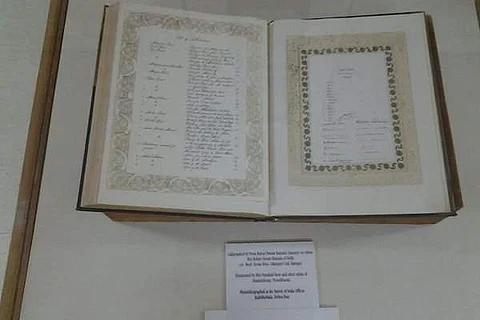

The original Constitution of India is hand-written both in English and Hindi, with each page decorated by artists from Shantiniketan including Beohar Rammanohar Sinha and Nandalal Bose. The illustrations represent styles from the different civilisations of the subcontinent, ranging from the prehistoric Mohenjodaro, in the Indus Valley, to the present. The calligraphy in the book was done by Prem Behari Narain Raizada. But the artwork needs to be preserved. This is how the CSIR-National Physical Laboratory, New Delhi is preserving it for decades:
The original Constitution, from 1950, is kept in a helium-filled case in the Library of the Parliament of India to preserve it for posterity. It is kept in a helium case because helium gas is inert and non-reactive and doesn’t support any organic or inorganic natural procedures and hence, keeps the document of the Constitution of India safe and unharmed.
D K Aswal and Ranjana Mehrotra in their historical note Constitution of India: Preservation of Original explain the working of the special case in detail. The challenging aspects of constructing the display case were to produce a hermetical seal with (i) mechanical strength so as to withstand changes in temperature and atmospheric pressure, and (ii) durability over several decades. The internal volume of each case is 96,250 cm3, and the dimensions of each case is 55 cm wide, 70 cm long, and 25 cm high. The documents are stored and maintained at a relative humidity of 40–50% in a nitrogen atmosphere with an oxygen concentration of less than 1% by volume. A special protective vault-like room, 180 cm wide, 180 cm deep, and 305 cm high was constructed in the Parliament Library at the Parliament House for display and storage of the documents. The room is climate controlled to maintain a temperature of 20°C (+/- 2°C) and a 30% (+/- 5%) relative humidity throughout the year. The cases were constructed at the GCI in the United States and transported to the Parliament Library in New Delhi, where they were installed and jointly tested by the GCI and the NPL. In March 1994, these cases were installed successfully. A trace-oxygen analyser connected to a data logger was installed in each nitrogen filled case to monitor oxygen leakage into it during performance evaluation. The cases were initially flushed with dry nitrogen, and oxygen content was reduced to below 1000 ppm. The performance of the cases was accepted by both National Physical Laboratory and GCI. The performance of these display cases is annually evaluated by a team of NPL scientists
